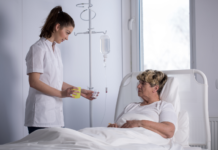Antibiotics are believed to be one of the greatest discoveries of the 20th century. Without them, there would have been more incurable diseases and a lot more lives lost.
We depend on antibiotics in treating almost all types of infections, from a simple ear infection to seriously fatal blood infections.
Now, imagine if antibiotics no longer working.
The idea is pretty scary if you think about it. And that goes not just for nurses but for patients, too.
Antibiotic resistance is a really serious threat and it kills about 23,000 Americans and sickens 2 million a year.
By now, you’re probably wondering…
What Causes Antibiotic Resistance?
If you want to eradicate a problem, one of the first things you need to do is know its root cause. For antibiotic resistance, there are actually a lot of reasons for its emergence.
The following are just some of its most common causes:
Overprescription of antibiotics
Not all infections are due to bacteria. In some cases, viruses and fungi are the culprits.
Unfortunately, differentiating a bacterial infection from a viral infection can be tricky without doing costly tests. It’s also more time-consuming.
As a result, antibiotics are being proactively prescribed to treat just about any infection, leading to an increase in antibiotic resistance.
Failure to finish an entire course of antibiotics

Antibiotics are supposed to be taken for a specific number of days to make sure that they can completely eradicate all the pathogens causing the infection.
When a patient fails to finish his course of antibiotics, the remaining bacteria begin to thrive and adapt to the presence of low dose antibiotics. In the long run, these bacteria create a population that’s completely resistant to the drugs, regardless of how strong or weak the dosage is.
Failure to control infection in the healthcare setting
With more and more people hospitalized because of infection, it can be quite tricky to stop its spread. Health care settings without strict and effective infection control policies are the ones that are more prone to developing antibiotic-resistant bacteria.
Lack of new and stronger antibiotics

Research isn’t able to keep up with the demand for stronger antibiotics. In fact, the development of new antibiotics has been at an all-time low in the last 40 years.
So, What Can You Do To Combat Antibiotic Resistance?
As a nurse, we are on the frontline of patient care and this makes our role bigger when it comes to prevention. Here are some of the things you can do to help control the situation:
- Always give antibiotics on time and make sure your patients are taking the right dose and by the best route.
- Be more aware of how your unit uses antibiotics.
- Strictly adhere to infection control and prevention policies.
- Do not dispose any unused antibiotics in your environment.
- Perform infection control practices, like hand washing, to prevent the spread of antibiotic-resistant bacteria.
- Make sure your patients aren’t skipping doses and that they complete the entire course.
- Reassess your patients’ antibiotic therapy every 2 to 3 days. Get their clinical and microbiological status once they are available.
- Make sure that all pertinent information about your patient’s antibiotic therapy are always available, like dosage, duration and indication. This will help the other nurses on your team have less difficulty in inquiring when to change or stop the course.
- Teach your patients about how they should take their antibiotics as well as the dangers of misusing them. They should also learn what antibiotic resistance is.
- Teach patients about practices that can control infection, like washing their hands and covering their noses when they sneeze.
- Make sure to document every antibiotic prescription, including the dosage and duration.
- Inform patients about the danger of taking antibiotics that are prescribed for someone else and taking leftover medication after they are done with their course.
- Be more proactive in participating in your institution’s antibiotic stewardship efforts to eradicate antibiotic resistance.
See Also: 8 Free Apps You Can Use for Patient Education
Conclusion
As health professionals, we are in the best position to participate in antibiotic stewardship efforts. We should work hard reversing the problem as well as its seriously fatal consequences by being more vigilant and proactive. If we don’t take appropriate actions now, it can cause more problems for everyone.
See Also: 5 Tips On How to Manage Patients Who Self-Diagnose




















